WhatsApp’s 2025 update surge is in full motion and South Africa is once again at the front of the global test pool. With more…
What you should know before signing up to Supersonic’s FLTE service

You probably wouldn’t think an internet service is worth reviewing. If it works, it works, and that’s all that really needs to happen, right? Naa.
To be frank, I thought reviewing Supersonic’s FLTE service would be a cakewalk, and it largely was for the final few days of my review. It otherwise demonstrated just what you should focus on when purchasing an internet plan.
Supersonic launched its FLTE offering at the bottom end of 2019, you know, the good ol’ days. It’s powered by MTN’s network plugged into Huawei hardware.
As an Afrihost client myself, which also piggy-backs on MTN’s network, the network provider is definitely a reliable bet. You’ll get good 4G signal in most areas across South Africa without much fuss.
However, this didn’t mean I didn’t have an issue with Supersonic itself.
Off to a rocky start
There was some fuss regarding delivery of the unit that may, or may not, be experienced by end users when ordering the package.
For one, it’s sent to the user’s place of residence after Supersonic confirms that LTE is available in your area. You’ll be required to RICA the SIM card, although I wasn’t informed of this (I wasn’t set to keep the SIM, but the couriers wouldn’t let me have the router if I didn’t provide a proof of residence… at my home).
*This would never be experienced by a new customer as the unit was an internal unit. We experienced some issues with courier process which we managed to rectify and have set up a process to avoid this moving forward.
Nevertheless, when I finally accepted the package, it included the router, SIM card (which was preactivated for review), and a note.
The note explained that the router was already set up for use, which meant that all I needed to do was slot the mini-SIM into the router. Once complete, internet should work without a hitch. This is what the note promised, but it didn’t include router or WiFi login credentials.
Ultimately, I was forced to reset the router and reset the network because I wasn’t given the router admin password or WiFi password.
*Again, this was due to the fact that the unit was an internal device so hadn’t been ‘set up’ for external use but would not be experienced by a customer.
As for the router, the Huawei B612’s interface is straight forward. It’s easy enough for anyone with minor tech knowledge to set up, which is a huge bonus for a product that’s meant to be plug-in-and-go.
What the note also omitted was the Supersonic APN details — effectively a key to the gateway of its internet access. For this, I turned to Supersonic’s WhatsApp chat support.
Now, any company that embraces a free, ubiquitous platform like WhatsApp for support gets a gold star in my book. What’s not acceptable is the extremely long wait times between replies from support staff.
The staffers also tend to follow a bullet point guide to solve issues, that usually begins with resetting the router, even when the issue clearly isn’t settings-related. It helps to be as verbose as possible when explaining issues.
I received the APN details within 15 minutes, which is excellent, but I later had issues with the SIM card locking.
FLTE actually sucks
And this is my biggest issue with FLTE as a service.
The F, or “fixed”, in FLTE mean that it’s supposed to be used at a single location, not on the go. This means if you purchase the package at one location, it won’t work in another. The SIM card will simply lock and disallow access to the internet altogether.
Locking a router to a specific location can ensure the router receives adequate LTE signal, improving service uptime. It also stops the consumer from abusing the lower FLTE prices versus traditional LTE data, which deserves an article of its own at some point. But this also presents a number of issues.
For one, if you live between a number of cell towers, the SIM will lock, and lock often as it darts from one to the other. If you move the router from one room of your house to another, it’ll lock, and lock often.
In my one month review period, the router locked three times without moving it beyond my address. Hell, it remained stationary on the same cabinet for the duration of my review.
Okay, cool. Understandable to an extent. FLTE is designed to do this. But where Supersonic really failed is the follow-up.
WhatsApp support was called in again for help on these three occasions, but remember those response times I mentioned earlier? The final time the SIM was locked, it took two days for support to get back to me. Literally. I sent a message on 22 March at 1.40pm. The issue was finally resolved on 24 March at 4.30pm.
I could’ve used alternative support methods, but if WhatsApp is the easiest available and is also free, why shouldn’t the customer use it?
Supersonic’s clearly heading in the right direction regarding communication with customers, but it needs to expedite replies on WhatsApp.
What Supersonic does well
Now, for the actual good news: when Supersonic’s service does work, it’s great.
I regularly achieved speeds in excess of 20Mbps, topping out at around 26Mbps at one point. Uploads are pegged at around 2Mbps, so it’s great for streaming YouTube and other video, downloading large files, or updating apps.
Gaming, while better than an ADSL line, still isn’t quite a brilliant experience. You’ll get no improvements over copper in terms of latency, but it does mean game downloads will be swifter.
The Supersonic package at my disposal retails for R399 per month and gives users 60GB of data between 6am and 11.59pm, and 60GB of data between midnight and 5.59am.
Spread across a month, that’s about 4GB per day across 24 hours. It’s enough for streaming at low resolution, and browsing social networks during the day. The late night data also encourages users to schedule downloads during the off-peak hours, but it does mean you’ll forgo that 60GB if you aren’t a night owl.
Supersonic’s FLTE rivals
So how does Supersonic’s package compare with other market offerings?
This excellent MyBroadband piece does the heavy lifting, but shows Supersonic isn’t the best or worst product in terms of offering or price per GB.
It’s not worth getting instead of fibre, but is definitely worth consideration if you’re still stuck on copper and are in an LTE area.
But I’d argue value for money doesn’t just include data costs, but customer care and uptime as well. I can’t argue that other companies treat clients any better, but I can say Supersonic’s WhatsApp support needs to improve, and quickly.
Beyond that, its FLTE service seems a perfect fit if you’re in a relatively small house or flat, within a thick MTN coverage area, or have no plans of moving your router.
*Editor’s Note: Post-review, Supersonic contacted us to explain that certain elements of the review wouldn’t be experienced by a general customer. Aiming for balance, I’ve allowed Supersonic to provide comments on these issues. I’ve included the company’s comments in the above review marked by asterisks.
Supersonic has also issued the following statement with regards to my WhatsApp support issues:
Since the country has needed to adjust to the global pandemic, we have been hard at work ensuring sufficient network capability and volume to be able to manage the national lockdown, and the volume of people who have needed to work from home. We do realise that support queries may be taking a little longer than usual given these numbers and for this we apologise.
Feature image: Supersonic


